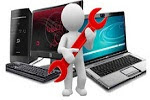What Is Device Manager?
Device Manager is an extension of the Microsoft Management Console that provides a central and organized view of all the Microsoft Windows recognized hardware installed in a computer.
Device Manager is used to manage the hardware devices installed in a computer like hard disk drives, keyboards, sound cards, USB devices, and more.
Device Manager can be used for changing hardware configuration options, managing drivers, disabling and enabling hardware, identifying conflicts between hardware devices, and much more.
Think of Device Manager as the master list of hardware that Windows understands. All the hardware on your computer can be configured from this centralized utility.
How to Access Device Manager
Device Manager can be accessed in several different ways in all versions of Windows, most commonly from the Control Panel, the Command Prompt, or Computer Management. However, a few of the newer operating systems support some unique ways for opening Device Manager.
Device Manager can also be opened through the command-line or Run dialog box with a special command.
Just to be clear, Device Manager is included in Windows—there's no need to download and install anything extra. There are a number of downloadable programs called Device Manager that do this or that, but they are not the Device Manager in Windows that we're talking about here.
How to Use Device Manager
Like what's shown in the example image above, Device Manager lists devices in separate categories so that it's easier to find what you're looking for. You can expand each section to see which devices are listed inside. Once you find the right hardware device, double-click it to see more information like its current status, driver details, or in some cases its power management options.
Some of these categories include Audio inputs and outputs, Disk drives, Display adapters, DVD/CD-ROM drives, Network adapters, Printers, and Sound, video and game controllers.
If you were having troubles with your network card, let's say, you might open the Network adapters area and see if there are any unusual icons or colors associated with the device in question. You can double-click it if you want more information about it or to perform one of the tasks listed below.
Each device listing in Device Manager contains a detailed driver, system resource, and other configuration information and settings. When you change a setting for a piece of hardware, it changes the way Windows works with that hardware.
Device Manager Availability
Device Manager is available in nearly every Microsoft Windows version including Windows 10, Windows 8, Windows 7, Windows Vista, Windows XP, Windows 2000, Windows ME, Windows 98, Windows 95, and more.
Even though Device Manager is available in almost every Windows operating system version, some small differences do exist from one Windows version to the next.
More Information on Device Manager
Different things happen in Device Manager to indicate an error or the state of a device that isn't "normal." In other words, if a device isn't in complete working order, you can tell by looking closely at the list of devices.
It's good to know what to look for in Device Manager because it's where you go to troubleshoot a device that isn't working properly. Just like you see in the links above, you can go to Device Manager to update a driver, disable a device, etc.
Something you may see in Device Manager is a yellow exclamation point. This is given to a device when Windows finds a problem with it. The issue may be extreme or as simple as a device driver problem.
If a device is disabled, whether by your own doing or because of a deeper problem, you'll see a black arrow by the device in Device Manager. Older versions of Windows (XP and prior) give a red x for the same reason.
To further convey what the problem is, Device Manager gives error codes when a device is having a system resource conflict, driver problem, or another hardware issue. These are simply called Device Manager error codes or hardware error codes.



No comments